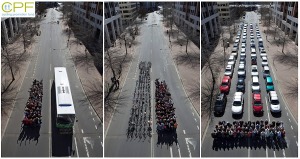4 million people in Melbourne and the road system is now at, or nearly at, full capacity. Projected numbers – 8 million.
But even doubling the road space will not prevent massive gridlock. This is because each person driving on the road takes up 20 – 200 square metres of space. So another 4 million people is not double the road space needed, it is 20 times the road space we already have.
Given that the growth is mainly in areas with very poor public transport, most of these people will drive to work and probably have 2 car families.
However trains and trams offer transport at about 1 – 2 square metres per person.
Bicycles take up about 2 square metres per person.
Public transport takes up no parking space.
You can park 2 bikes in 2 square metres of space, and utilise the walls as well.
One car takes up between 20 and 40 square metres of space to park.
It is simple fact that there will not be room for more cars, nor roads to drive them on, or space to park them.
Then you get the economics. Freeways return a loss of about 50 cents in the dollar, and fail in their defined purpose to move lots of people. Public transport also loses money, but succeeds in moving people. Bike infrastructure returns about $4 for every dollar spent.
The logic is inescapable; why are we even contemplating building these pointless roads?
transport use in square metres
References:
This is brilliant and pertinent to Melbourne:
http://www.ptua.org.au/myths/congestion.shtml
The British and American findings are now echoed by Victoria’s own Auditor-General. In 2011, an audit review of State government road projects found they had failed to account for the additional traffic generated by new motorways. In particular, the Auditor-General found that:
- The Hallam and Pakenham bypasses, costing $165 million and $66 million respectively when they were built in the early 2000s, had failed to reduce congestion in Melbourne’s south-east: instead they had attracted huge amounts of additional traffic. Within three years of opening, the Pakenham bypass was carrying levels of traffic that planners had not expected until 2031.
- Promised economic benefits of the Peninsula Link motorway have likely been overstated, and negative effects ignored, due to the failure to account for induced demand. It is therefore possible that the entire project was a waste of money – even before the budget blew out from $750 million to $1300 million during construction.
- The economic case for motorways is further undermined by accounting anomalies that are used to justify so-called Public Private Partnerships (PPPs). Building the Peninsula Link as a PPP may therefore be an even worse waste of money, due to the government artificially inflating the cost of having the road built by the public sector.
The Auditor-General specifically called attention to the failure of local road planners to heed the lessons from Britain, and called for induced demand to be factored into all future planning decisions.
[Road planners] did not adequately assess the traffic induced by these improvements, communicate the risks, or estimate the impact of the economic benefits. These shortcomings create a risk of over-estimating the benefits and giving decision-makers false confidence…. Unlike road authorities in the UK and New Zealand, VicRoads does not have adequate guidelines for forecasting traffic in congested areas.
—Victorian Auditor-General. Management of major road projects, June 2011.
https://theconversation.com/new-freeways-cure-congestion-time-to-put-the-myth-to-bed-13896




